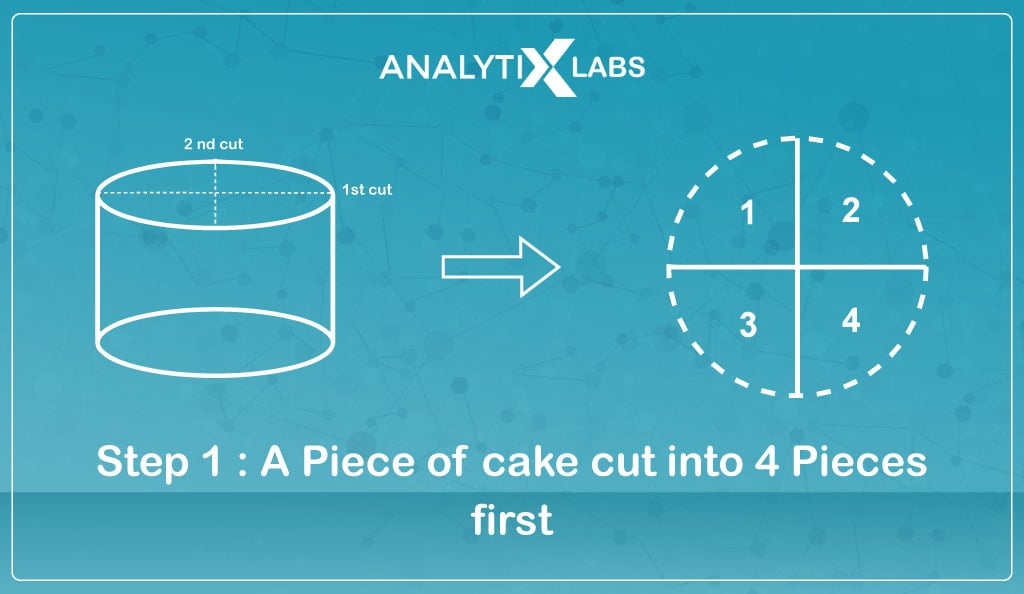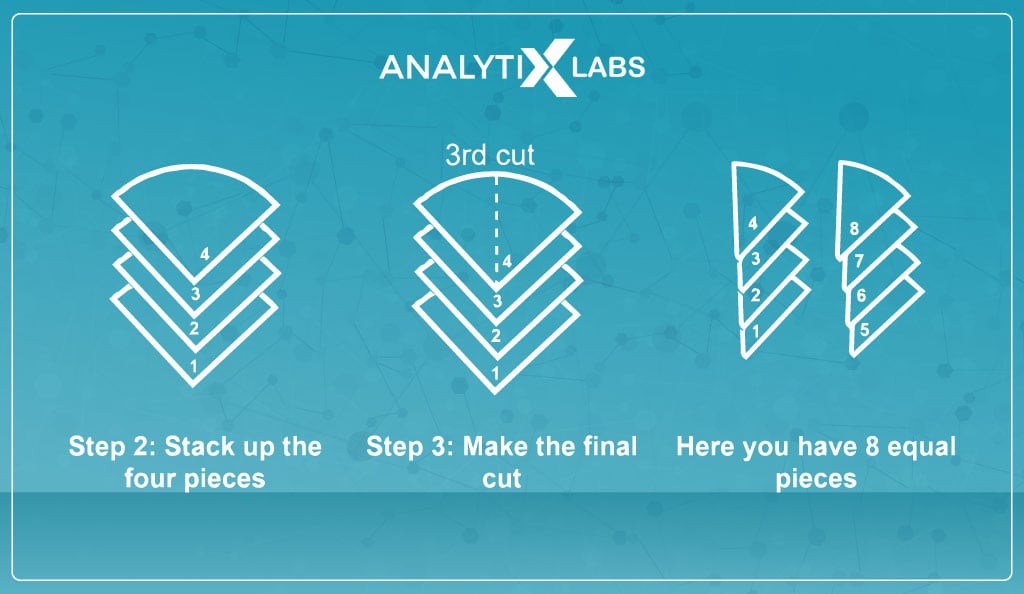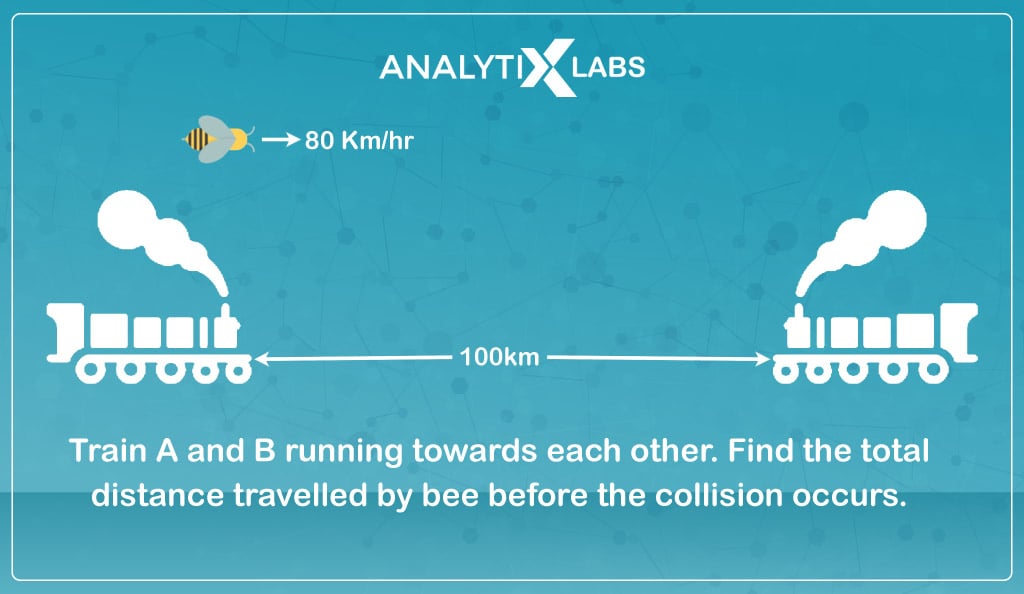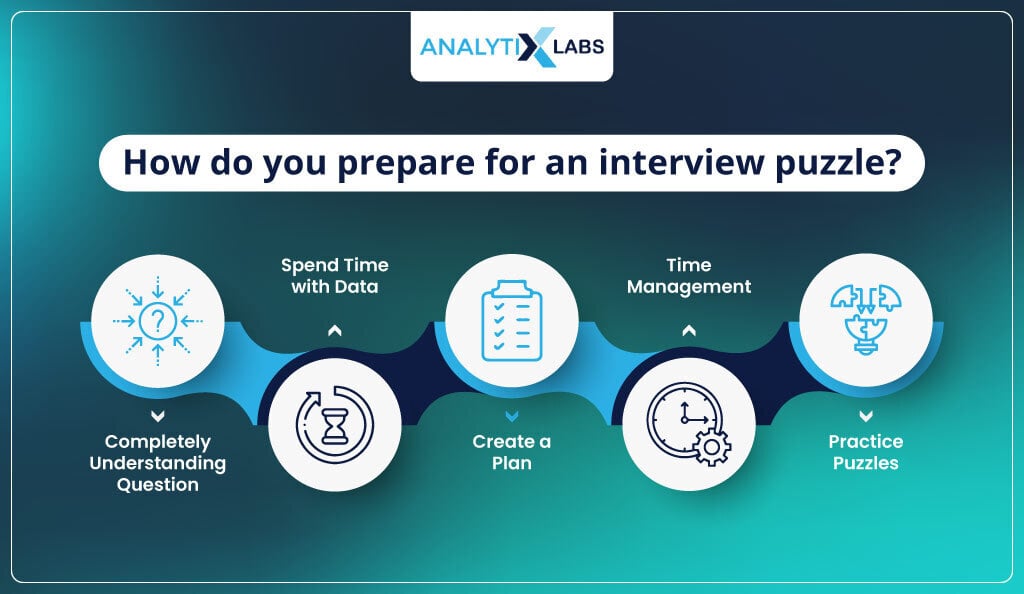The data generated by businesses today is at an all-time high, and so is the complexity of problems that companies have to face. This is why much emphasis on analyzing data is put today. The job role cut out to perform this task is a business analyst, and hence the importance of puzzle interview questions comes into play.
Interview puzzles serve as a means for hiring managers to assess problem-solving and lateral thinking skills. Like brain teasers, these puzzles embody critical thinking challenges that tap into lateral thinking and problem-solving capabilities. Interviewers leverage puzzle questions to evaluate a candidate’s adeptness in tackling intricate problems through strategic and higher-order thinking. Familiarity with common puzzle questions aids in planning responses beforehand, bolstering confidence during interviews.
This article will teach you what an analytical puzzle is about, the important ones you need to prepare, and how to prepare for them.
What is a puzzle question?

Interview puzzle questions test your ability to analyze information systematically. They require arranging details correctly and recognizing patterns to find answers. These questions reveal candidates with strong analytical skills, capable of linking information and forming decisions methodically.
There are several types of puzzles for interview questions and answers that you will find in this article. Common puzzle questions are – classification, arrangement, comparison, blood relation, and conditional selection.
Business Analysts play a pivotal role in bridging the gap between an organization’s IT and Business sectors. The current salary range in the BA field depends on several fields, like location, company, and more. While Bangalore has an average salary base of ₹798,008/ year, Delhi and Mumbai have ₹650,889/ year and ₹641,676/ year, respectively. Entry-level positions typically offer salary packages ranging from Rs. 3,50,000 to 5,00,000.
Now let’s look at a few critical BA puzzles with answers for interviews that can help you prepare.
Puzzle interview questions and answers
Following are the ten important puzzles for an interview that you must know.
Puzzle #1: Rat & Poision
Suppose there are 1,000 bottles of wine, of which one bottle is poisonous. If a rat drinks a poisonous bottle of wine, it will die after one hour. Your task is to find the poisonous bottle of wine. This puzzle requires calculating the number of rats needed to identify the poisonous bottle within an hour.
Solution:
The answer to this problem can be identified using the binary number system. You should use the Log21000, i.e., 10, and use 10 rats to solve this problem. You then label the bottles from 1 to 1000 and add the corresponding binary numbers. Each of the 10 rats is assigned a position in the binary numbers mentioned in the bottles.
Now, for example, in every bottle, if rat #1 is representative of the first bit, rat #2 of the second bit, rat #3 of the third bit, and so on, and rat #2, #3, and #6 end up dying then this would mean that the poisonous wine bottle is the 42nd one (with the binary label as 0000101010).
Puzzle #2: Bulbs and Switches

Let’s say three light bulbs work in a room with a closed door. These bulbs outside the room have three connected switches. You can manipulate the switches until you open the door using this puzzle, but once the door is open, you cannot manipulate the switches anymore. You must determine which switch is connected to each bulb.
Solution:
The way you did in the previous puzzle, the common step is to label the subjects in your puzzle. You label three bulbs here as A, B, and C and the three switches as X, Y, and Z.
First, you will switch on X for 10 minutes so that the bulb connected to this switch gets hot. You then switch on Y and open the door to check the light bulb that is on and then check the other two bulbs to know which one is hot and which one is cold.
Let’s say the hot bulb was A, the cold bulb was B, and the bulb light up when you opened the door was C. This would mean then-
- X connects A
- Y connects C
- Z connects B
Puzzle #3: Coins on Table
There is a table in a dark room that has 100 coins placed on top of it. Of these 100 coins, 10 show heads, while the remaining 90 show tails. As the room is dark, you can’t know which one is which. Your task is to split the coins into two groups, such as both the groups having an equal number of coins with heads up. You don’t need to have the same number of total coins in the two groups. Also, you can flip the coins of one pile once.
Solution:
You start solving this puzzle by making two piles of coins. Let us name the two piles of coins A and B, as you must always label things. Let the number of coins in pile A with heads up be ‘h’ and with tails up be ‘t’. Now let the number of coins with heads up be ‘10-h’ and with tails up be ‘90-t’ in pile B.
Now you pick a pile and flip the coins in it. For example, you choose the coin pile B and flip the coins causing the heads and tails to interchange. Therefore, in Pile B, the number of heads now will be ‘90-t’ and tails will be ‘10-h’.
Now let’s do some basic arithmetic.
number of coins heads up in pile A == number of coins heads up in pile B
i.e.,
h = 90-t
We can solve the above such that-
h + t = 90
Therefore, the number of coins in a pile A is ‘h+t’
Thus you need to split the coins into two groups, with one having 90 coins and the other having 10 coins.
Puzzle #4: Jars with Wrong Labels
Three jars on a shelf contain apricots, pears, and a mixture of both. However, they have mislabeled the jars. You can pick any number of fruits from the jars to correctly label them. Then you must determine the minimum number of fruits necessary to choose from the jar for accurate labeling.
Solution:
To solve this puzzle, you must pick only one fruit to label all three jars correctly. Let’s start by pointing out an essential aspect of this puzzle – there is circular misplacement involved in it. In this puzzle, you know that every jar is wrongly labeled, i.e., all the fruits are wrongly placed. This idea can help us in narrowing down on the correct labels as there can be two scenarios-
Scenario #1
You consider the jar with the label ‘Apricots’, meaning it cannot have only apricots in it, leaving us with two options- pears or a mixture of apricots and pears. If you get apricots, it would mean that its correct label is ‘Apricot+Pears’.
Now, move to the jar labeled ‘Pears’. Out of the two possibilities- apricots and a mixture of apricots and pears, it will be apricots as a mixture of apricots and pears is already found (and it obviously can’t be pears as all jars are incorrectly labeled). This will consequently mean that the last jar with the label ‘Apricots+Pears’ has apricots.
Scenario #2 (The correct approach)
However, there is another scenario also. If you pick pears when inspecting the jar with the label ‘Apricots’, then the method discussed above will fail as you will get confused between pears and a mixture of apricots and pears. Thus, you will be unable to assign the correct label to this jar rendering the next steps useless. To counter, you should use another approach.
Start with the jar having the label ‘Apricots+Pears’, and as the jars are mislabeled, this would mean that this jar either has apricots or pears and can’t have both. If you get pears, the correct label would be ‘Pears’; if you get apricots, the right label will be ‘Apricots’. Let’s assume you got pears here.
If you then consider the jar with the label ‘Apricot’ it will have two options- having pears or a mixture of apricots and pears. As pears have already been found, this jar should be correctly labeled as ‘Apricots+Pears’, making the third and last jar with the label ‘Pears’ have apricots.
Thus, as I said earlier, you can label all three jars correctly by just picking one fruit and using the process of elimination.
Puzzle #5: Faulty Battery
You must turn on a flashlight that requires a pair of working batteries. Eight batteries are available to you, out of which only four work. You need to find the minimum number of battery pairs you need to test.
Solution:
As mentioned earlier, you must start labeling the items mentioned in a puzzle. Here we label the eight batteries as A, B, C, D, E, F, G, and H. As you cannot compare two items directly, you need a combination of two batteries that you have to put in the flashlight, and if it fails to turn on, then it would mean that either one or both batteries are not working. Here again, like the previous puzzle, you need to solve it in a circular manner.
You can start with the following pairs- AB, BC, and AC. At most, between A, B, and C, only one battery is working if none of the pairs work. This would consequently mean that of the batteries D, E, F, G, and H, at least three will be functional. You can then try the combination DE, and if it doesn’t work, too, then this would mean that out of F, G, and H, at least two will work.
Finally, you can try FG, GH, and FH to find the two working batteries. Thus, a total of seven combinations is required.
Puzzle #6: Equal Cake Cuts


You are tasked with cutting a cake into eight equal pieces in 3 cuts.
Solution:
A little bit of imagination can do the trick in solving this puzzle. You can first slice the cake down from the center horizontally, and another division should be made vertically. This cake slicing across the vertical and horizontal directions will give you four pieces.
The last step is to stack all four pieces on top of each other and divide the cake by splitting it in half, providing you with the desired eight pieces. Such puzzle questions can be asked to test how to solve simple problems using a bit of imagination.
Puzzle #7: Distance Covered by Bee

Two trains are approaching each other on the same track. While the speed of the first train is 50 km/h, the speed of the second train is 70 km/h. A bee starts to fly from the first train to the second when the distance between the trains is 100 km. When the bee reaches the second train, it returns and flies back to the first train. The bee keeps doing this back and forth at the speed of 80 km/h until the two trains collide. You need to find the total distance traveled by the bee.
Solution:
Such puzzle questions test your aptitude and basic mathematical skills. Here it would help if you focused on the relative speeds of the two trains. Let’s label the first train as ‘A’ and the second train as ‘B’. With respect to the first train, ‘A’, the speed/velocity of the second train, ‘B’ will be 70 km/h + 50 km/h = 120 km/h (we add the speed of the A with B as B is moving towards it).
Now we need to calculate the time it will take for the two trains to collide, and this would be the distance between the trains divided by the speed, i.e., 100 km / 120 kmph = 5/6 hours or 50 minutes.
You should now consider the bee’s velocity, which is 80 km/h. To calculate the distance traveled by the bee, you can multiply this speed by the time remaining in the collision, as for this duration, the bee will keep going back and forth.
80 kmph * 5/6 hour = 66.67 km
Thus, the bee would have traveled a total distance of approximately 66.67 km before the two trains collided.
Puzzle #8: Jugs and Water
Two jugs have 4 liters and 5 liters of water capacity. You are tasked with filling up a bucket with 7 liters of water. You must use the jugs to measure the water in the bucket.
Solution:
This is one of the most commonly asked puzzles. You must know that answering this puzzle shouldn’t take you more than two minutes. Let’s first label the jug with 4 liters of water capacity as A and the one with 5 liters of water as B. Now you fill B with water and pour the water from it into A. This will leave B with 1 liter of water you will pour into the bucket.
You then empty A, repeat the process, and add one more liter of water in the bucket making the total water in the bucket 2 liters. Now you fill B and empty it in the bucket, making it have 7 liters of water.
Puzzle #9: Measuring Time using Sand
You need to measure 9 minutes and have only two sand timers lasting 4 and 7 minutes, respectively.
Solution:
As usual, start with labeling the timers. The sand timer with a capacity of 4 minutes is called ‘A’, and with 7 minutes, be called ‘B’. The key to solving this puzzle is to time when you flip the sand timers. You can solve this puzzle in just four steps.
- Start the sand timers A and B.
- Once A ends, turn it upside down to let it start again.
- Turn it upside down once B ends to let it start again.
- As soon as A ends, turn B upside down, as it will only have a minute’s worth of sand left.
Thus by flipping A twice, you will get 8 minutes, and through the last round of B, where you have only one minute of sand left, you will get the additional one minute, effectively providing you with 8 + 1 = 9 minutes.
Puzzle #10: Hats and Prisoners
There are ten prisoners on death row. The warden gives them a chance to survive the execution. The game is that on the execution day, all ten prisoners will be made to stand in a line and will be made to wear a hat that can be black or white in color. The prisoners will not be allowed to see the color of their hats. The executioner will ask each prisoner about the color of their hat starting from the last of the line, and they have to answer in ‘black’ or ‘white.’
If a prisoner fails to answer correctly, he will be executed. Also, the catch is that if all the prisoners give the correct answer except the prisoner last in line, he still will not be executed. What plan should the prisoners come up with to survive?
Solution:
While this puzzle seems sadistic, it has an interesting solution. The prisoner last in the line will be able to see the color of the hat of all the prisoners standing ahead of him (therefore, every prisoner can see the color of the hats of all the prisoners in front of him). However, the prisoner at the start of the line will not be able to see anything (a prisoner can only see the color of the prisoners’ hats ahead of him and not behind him).
The key to solving this puzzle is for the prisoner last in line to convey coded information through the term ‘black’ or ‘white’. You need to ask what does have two possible values is that numbers parity- whether a number is odd or even. So the strategy is that the last person in the line will say ‘black’ if he counts the number of hats in front of him as odd and ‘white’ if he sees an even number of black hats.
To help you better understand this technique, let’s take an example and use the technique every step of the way. For example, the hats are distributed as (from the back of the line) – white, white, black, black, white, white, white, white, white, black.
The prisoner last in line sees three black hats and says, ‘Black’. This informs everyone that he sees an odd number of black hats. The second last prisoner also sees three black hats, i.e., an odd number, so he knows that his hat color must be white and yells ‘White’. The third last prisoner sees an even number of black hats and concludes that his hat must be among the odd number of black hats the last two prisoners saw and therefore must be black and yells ‘Black’.
Now the fourth last prisoner looks for even more black hats since one black hat is behind him. As he only sees one black hat ahead of him, he concludes that his hat also must be black.
From this point forward, the remaining prisoners are looking for an odd number of black hats, and as they only see one black hat (of the prisoner standing in the front of the line), they all give white as the answer. When the executioner reaches the prisoner standing first in line, he knows that the prisoner at the last place said black, meaning he saw an odd number of black hats.
Two prisoners have already said that their hat color is black, and he is the one last in line, so his hat color must be black.
Thus this parity information conveyed from the last prisoner to the first allows everyone to be freed.
We hope you gained some understanding of how to solve puzzles. However, you must follow certain tips to solve puzzles on your own.
Also read: Top 35 Business Analyst Interview Questions & Answers
How do you prepare for an interview puzzle?

All the above-mentioned puzzles with answers for interviews for BA job roles tested your aptitude and analytical and problem-solving skills. However, there are many puzzles interview questions and answers that are out there that can make their way into your BA interview.
Therefore, learning to solve such questions becomes crucial even if you haven’t seen the question before. While there are multiple methodologies through which you can prepare for the BA puzzles for an interview, the following are the most effective methods-
Completely Understanding Question
The best way to find a solution to any problem is first to comprehend the problem entirely. Similarly, in any puzzle, you must thoroughly understand the aim of the question and the expectations from your answer.
If you misinterpret the question, you will start thinking in the wrong direction, causing you to arrive at the wrong conclusion. Thus, you must read the question multiple times. If the questions are not online and asked by an interviewer, clarify your doubts about what the question means.
Spend Time with Data
As mentioned in the beginning, the whole intent of the puzzles is to find the correct order of things and connect the dots. One of the key ways to master this is to pay attention to the data. Therefore, you must properly understand the data at hand. Let’s say you have two tables with information; you must carefully read the column names, analyze the data, and look for a connection between them.
Create a Plan
When you come across a puzzle, have understood the question’s expected answer, and have analyzed the data, you must start creating a roadmap on how you intend to solve the problem. You can start by outlining the potential methods to employ and then discard the ones you consider ineffective.
Time Management
If there are several interview puzzle questions, you must manage the time you take to solve them. The best practice to manage time is to go through the questions quickly and try to solve the ones that seem more accessible. Also, have a time limit for your questions. And last, never get bogged down on a single question. If you cannot solve a question within the time limit you have designated for yourself, move to the other question and return to it later.
Practice Puzzles
The most effective, though not the most efficient, method of preparing for puzzle questions is to practice them as much as possible. You can google ‘interview puzzle question for business analytics interview’ and go through the various websites that provide you with the questions.
If you go through enough questions, then most probably, the puzzle question you will come across in your interview will be the one that you would have already seen or will be a derivative of it. Going through several puzzle questions and answers will help you understand how to approach puzzle questions.
To get a jump start in your BA career, you can enroll in our certificate course in business analytics and learn all the fundamentals and advanced aspects at your convenience, or you can book a demo with us.
FAQs:
- What is the benefit of using a puzzle question in an interview?
Puzzles for interview help in examining the analytical skills of a person. Business analysts work with a lot of chaotic data and analyze it to find answers, making puzzles a way to test this capability.
- Are puzzle interviews effective for employee selection? Why or why not?
As mentioned above, while puzzle help in testing the problem-solving capabilities of a person, they should not be the sole basis for rejecting or accepting a candidate. In real life, problems have multiple facets, and a person who can solve a puzzle may or may not be able to solve the practical problem.
Also, getting the correct answer to a puzzle can be a product of already knowing about it.
All the puzzles for an interview for a BA job profile mentioned in this article will help you immensely. If you have any issues, then do right back to us.

![Top Puzzle-Questions Asked in Business Analyst Interview – With Solutions [2024 Edition]](https://www.analytixlabs.co.in/blog/wp-content/uploads/2023/08/Puzzle-Questions-for-BA-Interviews.jpg)






